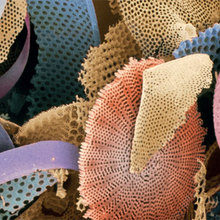Editorial
17 November 2014

As I write this editorial the most recent Climate Summit is taking place in New York. It has been accompanied by more than 2,000 demonstrations staged in 150 countries, including marches in major cities such as Rio de Janeiro, Lagos and Bogotá. London saw more than 30,000 marchers backed by celebrities such as Emma Thompson, Vivienne Westwood and Peter Gabriel to raise awareness.
The Summit highlighted action and the need to build resilience in countries at ‘greatest risk from rising sea levels, precipitation, droughts and extreme weather events that can destroy decades of development gains overnight’.
The changes in movement and behaviour of both water systems and water cycles that accompany climate change include a re-sculpting of lands, a changing environmental biodiversity, and impacts on human wellbeing and health. The idea to devote this edition of Microbiology Today to water was conceived as Britain suffered some of the worst floods that it had seen for generations. Our relationship with water is changing and we were keen to explore how micro-organisms are also changing their interactions with this ubiquitous substance.
In this issue David Walsh’s article explores this idea as he examines the consequences of climate change on microbial marine life, asking questions such as ‘how many species are there in the ocean and what governs their distributions?’ and ‘what role do these highly diverse microbial communities play in the ocean food web and global biogeochemical cycles?’ Mike Allen discusses the interaction between phytoplankton and the viruses that infect them. These infections cause the phytoplankton cells to lyse, releasing nutrients back into the seawater. This relentless lytic function is fundamentally important to global biogeochemical cycling and ecosystem function, which would collapse without the constant recycling of nutrients at the microbial level.
Brian Austin has written an article that examines the aquaculture industry. He outlines the benefit that this ancient industry has provided and continues to provide to world economies. However, there are also inherent risks of infection with the decision to farm large quantities of the same species in confined spaces.
Human health has been affected by contaminated water for millennia. Modern technology associated with our water use has had both a positive and a negative effect on human health. Mike Dempsey has written an article that describes how we use microbiological treatment of ‘used’ water to protect public health and the aquatic environment. On the other hand, I have written an article that describes how Legionella, a common microbe found in the environment, has become a health risk as we have created man-made water supplies. Other articles shine spotlights on the raft of imaginative, varied events that our Society and Society members have organised and undertaken to engage the public with the microbial world.
Finally the Comment piece, Hydraulic fracturing: what do microbes have to do with it? by Lee Stanish discusses the role that microbes play in groundwater quality and outlines our present understanding of how pollutants, (such as those caused by fracking) can alter the composition of groundwater microbial communities.
As this edition arrives though your letter boxes winter will be underway in the United Kingdom and the countries of the northern hemisphere. When it comes to storms, flooding and winter weather, I wish you all a kind one.
LAURA BOWATER
Editor
[email protected]


